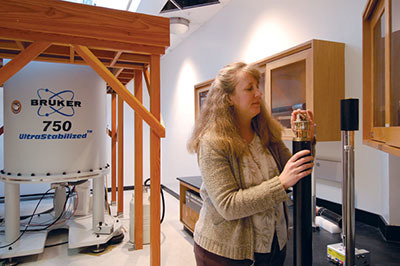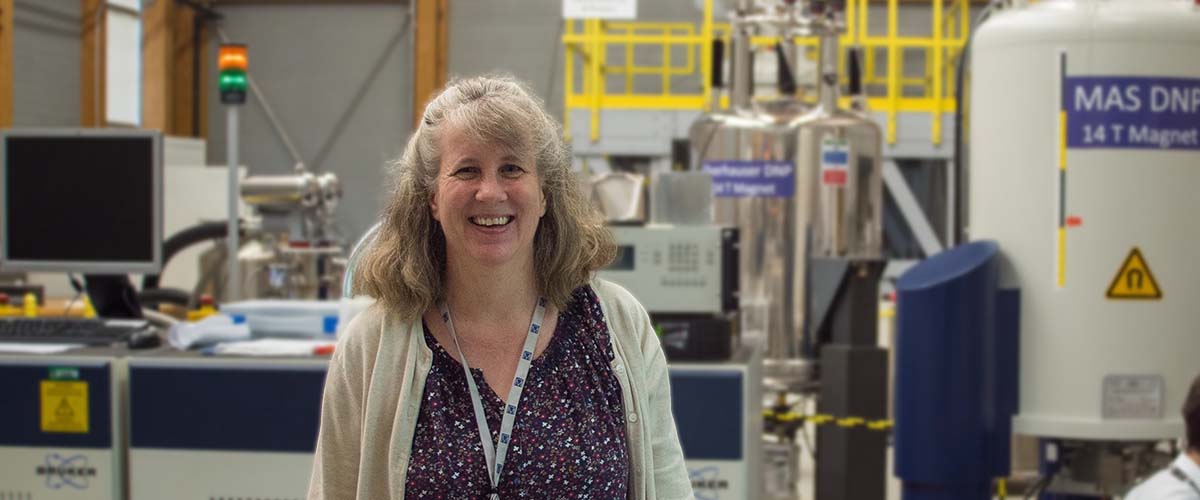Experimental science can be a messy business, but you'd never know it coming through the front doors of the University of Florida's McKnight Brain Institute. White walls lead down white halls into white rooms, each door neatly labeled. Behind one of these doors is Joanna Long's office, an unpretentious jumble of papers and books that's nothing like the space outside it.

Joanna Long inspects a probe in front of the 750 MHz superconducting magnet at AMRIS.
Long is at the helm of AMRIS, which stands for Advanced Magnetic Resonance Imaging and Spectroscopy. AMRIS is a thriving, highly collaborative and interdisciplinary research group — and it's also the home of one of the Magnet Lab's two user programs based at the University of Florida (the other user program, the High B/T facility, will be featured in a future issue of flux).
AMRIS houses a variety of state-of-the-art magnet systems and instruments that biologists and biochemists use to take extremely high-resolution images of everything from humans to single cells. For example, scientists can image the brain to study the effects of epilepsy, strokes, spinal cord injuries, tumors, Alzheimer's and Parkinson's disease. The program works closely and collaboratively with the lab's Nuclear Magnetic Resonance (NMR) user program in Tallahassee, and together they comprise the Magnet Lab NMR Spectroscopy and Imaging Program.
Each day at work, Long, an associate professor of chemistry and biochemistry, tackles the twin duties of providing administrative leadership for a program that's intent on growing its user community, and her own team's scientific research. But we'll let Long tell us a little bit more about that herself.
You grew up in a small town in Kansas. How did you end up a biochemist?
Probably the thing that really stands out is that even as a young kid I was always really interested in math and patterns, and how things fit together. I came more from the "how do things work" engineering standpoint than the "let's blow up things" chemistry standpoint. I think in science and particularly the science we do here at the Magnet Lab, there's a lot of room for both kinds of scientists.
I grew up in a small town where there wasn't much of a science curriculum in the early grades, and school had very little to do with my interest in science up until high school. My dad's a doctor, and we come from a family that has many scientists, and I had a chance to see it as a working profession. I also got National Geographic World as a kid. That and Discover magazine are great when you're in middle school and high school and you're getting interested in how things work. One of the best things my parents did was get me those subscriptions because it cemented that curiosity for me.
And when did science and school come together for you?
My high school chemistry teacher realized where my interests laid and he took a lot of time out to make sure I knew what my options were and to steer me in different directions. Probably my uncles, who were chemists, and my high school chemistry teacher were the reason I ended up in chemistry specifically. I always knew growing up that I was going to go into science or engineering, because that's what I liked. I cut my English classes, but I went to my science classes
What was the male/female dynamic like for you?
I think because I come from a small town where there weren't magnet programs, a lot of the interest in science and math from girls dropped off really early. I don't think there was ever conscious discrimination. It was all about expectations. The teachers certainly focused more on the boys in math and science classes in elementary and middle school. Even at a young age you do experience that. In my freshman year of college, I took the Honors science and math courses, and I was the only female in the physics courses. In most of my upper level chemistry courses, there were only two or three of us — and I went to a major state university.
My sons are doing these math contests. When I picked them up the other day I noticed that on their team it's five boys and one girl. You learn even as a teenager how to navigate that as a female or you don't make it.
A really eye-opening experience for me was how my husband, who is the same age as me, was mentored. We went through the same undergraduate program, and on paper, if we didn't write our names down we looked identical, same grade point average, standardized exam scores, etc. We started dating in my sophomore year of college and I just remember my junior and senior year being flabbergasted at the differences in the quality of mentoring we were getting. I'll confess, I took a lot of the advice my husband got and used it. I think to this day that if I hadn't been dating someone in the same major it might have turned out differently.
What appeals to you about academia?
A. It's the space you have to solve problems, to figure things out. I think nothing of pursuing a problem to figure out why something doesn't work or make sense, backtracking for five years if I have to. I actually enjoy it.
On the other side of it, teaching helps to keep me honest. I can get so caught up in solving a particular problem, and there always needs to be an element of relevance to the question you're pursuing. Students will ask you outright, "What are you going to do with that? What problem are you going to solve once you find this out?" And I think students really keep you on top of that.
What are some of your most important goals for AMRIS?
A. One of our major goals has been to expand our external user program, partly because we've had a lot of developmental projects that have really turned out well. We are trying to bring in people who have never thought about magnetic resonance and show them how it could illuminate their work. It's a real challenge in terms of how you do that — how much technical info do they need? How many resources do you dedicate?
As our magnet systems improve, our current users take less time to get their data, so we have room for more, new users. Now it's time for us to move to prime time and let people who don't normally use magnetic resonance know that it's relevant to their research.
By Amy Mast



